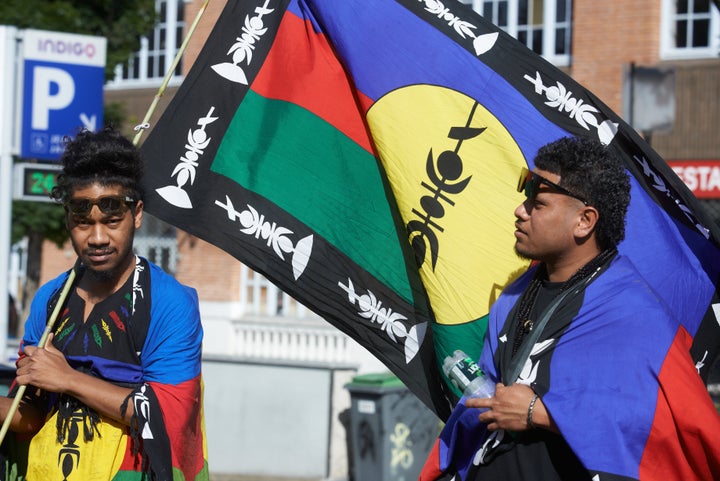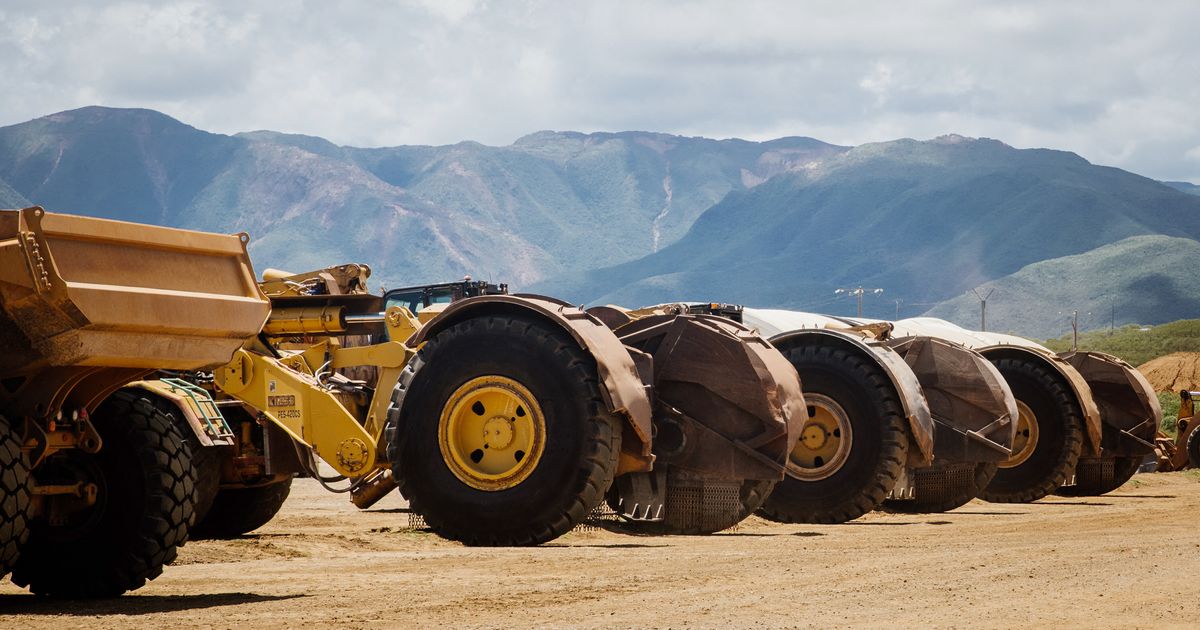The deadly riots that broke out earlier this month in the French territory of New Caledonia are pushing up the price of nickel, a key metal needed to transition off fossil fuels that has gotten more expensive as global conflicts affect the market.
The South Pacific archipelago, located roughly 1,000 miles off Australia’s east coast, was the world’s third-largest producer last year of nickel. The metal is used for everything from steelmaking to solar panels, but is particularly prized as an ingredient in batteries for large machines like electric vehicles, allowing them to last longer on a single charge.
Nickel prices dipped last year as electric car sales stalled out, allowing a surplus to pile up in warehouses around the world. But prices spiked again in February, when Swiss mining behemoth Glencore announced plans to exit New Caledonia and sell its half of one of the territory’s biggest mines.
Then, in April, new Western sanctions against Moscow prompted the Chicago Mercantile Exchange and the London Metals Exchange ― the largest U.S. and world markets for options and futures contracts on metals, respectively ― to ban Russian-produced nickel. With projected demand for nickel already outstripping the world’s current planned supply, cutting a major producer out of the market hiked prices.
Now, simmering unrest in New Caledonia, which some commentators have likened to a dawning “civil war,” has prevented any shipments or production of nickel, sending the price of the metal surging by more than 7% in recent weeks. It’s just the latest squeeze, but raises doubts over the West’s capacity to rewire supply chains and reduce dependence on geopolitical rivals such as China and Russia.
Anticolonial Backlash
Protests broke out in early May after French President Emmanuel Macron moved to pass legislation that would deflate the political power of the native Kanak people, seemingly thwarting their hopes of gaining independence from the European power that conquered their homeland 171 years ago.
France retains more than a dozen overseas territories as a legacy of its empire, which crumbled after World War II. As the U.S. did with Hawaii and Alaska, France fully incorporated five of its territories in the Caribbean, South America and the Indian Ocean into its political structure. Other French colonial islands, mainly in the Caribbean and South Pacific, assumed a secondary status as “overseas collectivities,” akin to America’s relationship with Puerto Rico or Guam.
After slotting New Caledonia into that latter category in 1946, France granted the Kanaks citizenship and allowed the ethnically Melanesian natives to live freely outside the tightly controlled reservations to which they were confined following colonization in 1853. Kanaks enjoyed a slight majority over non-native settlers, mostly of European descent.
In the 1970s, a nickel boom spurred by U.S. demand for weapons in the Vietnam War brought an influx of roughly 25,000 migrants from Europe and across the region to New Caledonia, a territory of about 80,000 at the time. Kanaks became a minority in their homeland.

DELPHINE MAYEUR via Getty Images
In 1980, the neighboring island chain of Vanuatu declared its independence from France. Inspired by that, and by other anti-colonial struggles in formerly French-ruled Algeria and Vietnam, Kanak nationalists launched what one historian called a series of “extraordinary confrontations” in New Caledonia, “marked by hostage-taking, blockades and assassinations.”
The 1998 settlement that ended the conflict laid the groundwork for three separate votes on the island’s independence, after a 20-year transition period. The results were not immediately binding. But if New Caledonians voted all three times in favor of breaking away from France, it would likely have set the stage for independence. In a concession that improved Kanaks’ odds, the deal also froze registration to keep newly-arrived voters from diluting the Indigenous vote, even as their share of the population shrank.
The first two referenda, in 2018 and 2020, saw the island vote against independence overall, though most Kanaks voted in favor.
The third and final referendum was scheduled for 2022, but Macron’s government moved the date up a year. The move outraged Kanaks, who said a 2021 vote put them at a disadvantage because their communities had suffered the vast majority of New Caledonia’s deaths from COVID-19 and were still racked by grief. When France rejected Kanaks’ pleas to stick to the original plan, Indigenous campaigners urged voters to boycott. Half as many eligible voters turned out for the third vote as for the first two, and almost all of them rejected independence. Kanaks called the vote invalid.
Kanaks largely saw the French government as seen as a fair arbiter between themselves and the loyalists when the 1998 agreement was negotiated. Regardless of the outcome, Paris pledged to bring all sides together after the final voters were tallied to “sit down and negotiate a new territorial arrangement,” said David Chappell, a professor emeritus of Pacific history at the University of Hawaii.
Instead, Macron’s government sided with the loyalists, accepting the results and promptly introducing legislation in the French Parliament to extend full voting rights to New Caledonia residents living in the territory for at least 10 years. Those new, non-Kanak residents would likely vote against independence, dimming hopes of gaining independence at some point in the future with another vote.
Kanaks “now feel left out and cheated,” Chappell said. “The spirit of the [deal] was collegial and consensual, but the Kanak now fear they will lose their voice in their own country if another 40,000 settlers can vote, without any accompanying assurances of other decolonizing reforms.”
Nickel And Dimed
New Caledonia’s place in the nickel supply chain was slipping before the riots.
The industry consists of three major producers. The largest mine, Doniambo, and the second-largest, Koniambo, each mined and smelted nickel ore into ferronickel, a metal used primarily in steelmaking. The third, called Prony Resources, makes and sells a nickel-rich mixed-metal compound known as MHP, which is used in batteries.

THEO ROUBY via Getty Images
The price of nickel soared to over $22,000 per ton in early 2023, but finished off the year just above $14,000 per ton, as electric vehicle sales slowed.
“With prices falling, the producers in New Caledonia are at the wrong end of the cost curve,” said Adrian Gardner, the principal nickel analyst at the market research firm Wood Mackenzie.
Unable to compete at those prices with cheap Chinese and Indonesian nickel, all three producers in the territory asked the French government this year for new subsidies to stay afloat.
In February, Glencore announced plans to sell its 49% share of Koniambo and stop funding operations by May, grinding production to a halt for this year.
In recent years, New Caledonia produced up to one-fifth of the world’s ferronickel supply, selling mostly to manufacturers in Asia. But as the U.S. looks to cut China out of industrial supply chains and reroute minerals and investments to friendlier countries, a major producer in a territory controlled by one of Washington’s most powerful NATO allies should, at least in theory, command some kind of premium.
That’s particularly the case since one of the biggest ferronickel projects in the Western Hemisphere — a facility in Brazil, to be operated by London-based Horizonte Minerals — was canceled this year.
“At the same time we lost Koniambo’s ferronickel, we’ve lost a potential new source in Brazil that would have serviced the U.S. and European stainless steel markets,” Gardner said.
The battery-grade nickel coming from New Caledonia’s Prony project is unlikely to make its way to American battery factories, because there are no U.S. facilities to process MHP into the next-stage product needed for lithium-ion packs. If that material goes to battery makers in South Korea or Japan, which have free trade agreements with the U.S., it counts as though it were mined in New Mexico or New York in the eyes of the federal agencies giving out the most lucrative American tax credits for electric vehicles.
But China accounts for 80% of MHP processing, Gardner said. Indonesia, which has the world’s largest known nickel reserves, is increasing production of raw ore more than any other country, giving Jakarta control over nearly 40% of the global market. China-based Tsingshan Holding Group, the world’s largest company producing nickel, is expanding its operations in Indonesia.
If policymakers “want the U.S. industry to avoid Chinese investment or involvement, it’s a hard sell, because China’s control over global nickel is quite dominant,” Gardner said. “Even if you have 20 free trade agreements with countries, it still puts North America and the U.S.A. in a tight spot.”
With nickel output higher than Canada or Australia last year, New Caledonia remains, via France, the West’s top domestic producer of the metal. But a new boom in the territory seems far off. No buyers have yet emerged for Glencore’s stake in Koniambo, and Gardner estimated that there’s basically no price point that would motivate the Swiss giant to reverse its decision.

DELPHINE MAYEUR via Getty Images
“This is a long term view Glencore is taking. … They want to exit New Caledonia,” Gardner said. “I don’t care if prices went up to $50,000 a ton. It’s been quite an unstable country to do business in, and it never has been a low-cost country to do business in.”
Where Things Go Now
After sending troops to New Caledonia quell riots, Macron visited the island last week and promised not to “force” the voting reform. The state of emergency officially ended this week, but a curfew remained in place as of Tuesday. Airports finally reopened this week, too, allowing stranded tourists to return home.
The path forward remains unclear.

NurPhoto via Getty Images
While youth protesters are demanding independence, “my own position is that a small Pacific nation of 500,000 would not be viable, would be subject to influence from China, would lose its current very high standard of living,” but might have a more equal distribution of wealth,” said Raylene Ramsay, a professor emeritus at New Zealand’s University of Auckland and one of the leading English-language scholars of New Caledonian culture.
“There is now a new group of ‘middle-class’ Kanak, politicians and thinkers, who want progress for the Kanak people through [dialogue] and do not see radicalism and violent opposition to the French State as the best way forward,” Ramsay said in an email. “But it is also difficult for many in the older generation who spent their lives as independence activists to not show solidarity with their peoples’ cause.”
The inequalities are stark. Kanaks’ poverty rate is above 32%, compared to 9% for non-Kanaks. More than half of European-descended New Caledonians are university educated, and 24% of people with mixed heritage hold college degrees. But nearly half of fully Indigenous Kanaks hold no high school diploma, and just 8% graduate from university, according to 2019 census data Reuters cited.
“There is looting and ransacking, but we have a population that is on the margins of society, they have no work, nothing to eat, they’re failing at school, they live in slums, and then next to that you have the rich neighborhoods,” Dominique Fochi, secretary general of the pro-independence Caledonian Union, which opposes the electoral reform but called for peaceful protest, told Reuters. “It is a people that is fighting for its dignity.”
Workers in the nickel industry have weathered job cuts before, as happened at Koniambo when metal prices plunged in 2016. Glencore said it would retain all workers until August to help shut the facility down and “aid in the transition.”
The open question: To what?

